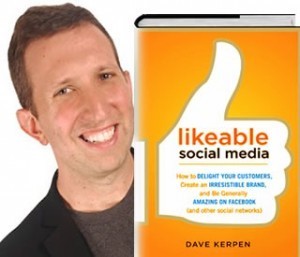Erik Qualman's Blog, page 649
November 5, 2012
Where are they now? Retro brands that rock social media!

Remember the toys and brands you couldn’t get enough of as a kid? The toys that entertained you, the candy and the drinks that made the perfect afternoon treat. Well, nostalgia isn’t lost in the world of social media. The brands you loved all those years ago are active on the social network and they are just as fun as they’ve always been.
Lisa Frank: Remember all those unicorns, ponies and psychedelic colors from the 90’s? These characters and colors still come to life everyday on the Lisa Frank Facebook and Twitter. Currently they’ve teamed up with Urban Outfitters and are hosting an illustration contest. Asking people to submit their Lisa Frank Drawings using the hash tag #UOxLisaFrank! Check out the details here http://urbout.co/RMOZvb.
Hot Wheels: This brand is alive and well and their Facebook page is worth stopping by. In addition to being engaging and a fun, hot Wheels just announced the first life size version of one of its cars. Finally, a hot wheels car that you can’t accidentally step on in the middle of the night! Check it out here http://on.fb.me/RMPeX7.
Orangina: Everyone’s favorite orange soda bottle has just introduced a new brand mascot into the social media space. His name is Bulby and he has set out on an adventure! I covered the finer details of the campaign in this previous post, but for now go visit their Facebook page and have fun remembering this amazing orange soda http://bit.ly/QiCjkD.
Lemonheads: Occasionally, I still find a need to enjoy this candy – It’s one of my childhood favorites! Their Facebook page is currently full of fun photos, contests and giveaways! Stop by http://on.fb.me/QiCwo2.
Mattel: The Mattel brand is known for producing iconic and memorable toys and games. Their Facebook page is an ode to their incredible legacy. Even better they are currently doing “A Toy A Day Giveaway” http://on.fb.me/QiCBYQ.
Barbie: Barbie dolls are a staple in every little girl’s set of toys. This glamorous brand that loves to reinvent itself and they are using social media as a way to connect with new fans. On their Facebook page you will find a lot of links and posts that point to their web-t.v. Series – Yes, you heard us right, Barbie has her own cheesy show! If you follow @BarbieStyle on twitter, you get access to the voice of Barbie and her tweets.
What are your favorite retro brands? Tell us in the comments!
[image error]
A Marketer’s Guide to Social Scoring (Infographic)

Want to drive engagement and sales from your social media leads? How about increasing conversion rates by 79%? I explain the various steps of developing a social lead scoring program and more in my upcoming book, Stand Out Social Marketing: How to Rise Above the Noise, Differentiate Your Brand, and Build an Outstanding Online Presence.
Explore our infographic below for a three step “how-to” guide on social lead scoring.
For more strategies and tactics to gain the social customers’ attention, be sure to read Stand Out Social Marketing, available in stores and online starting November 9th.
[image error]
Online Voting
Social Media Keynote Speaker Erik Qualman asks the question “Online Voting – where is it?
[image error]
November 2, 2012
2012 Daylight Savings

TODAY: A friendly reminder to roll back your clocks in the U.S. one hour at 2 a.m. on Sunday, November 4, 2012. What are you going to do with that extra hour? Perhaps send out a few more tweets or Facebook that boy you have a crush on? We decided to use the extra hour to launch the revised edition of Socialnomics with 12 brand new chapters and modifications to the existing 8 other chapters. It was nominated for the American Marketing Associations’s Book of the Year and reached #1 in 8 different languages. Perhaps you might spend your extra hour reading it with a nice glass of wine?
more tweets or Facebook that boy you have a crush on? We decided to use the extra hour to launch the revised edition of Socialnomics with 12 brand new chapters and modifications to the existing 8 other chapters. It was nominated for the American Marketing Associations’s Book of the Year and reached #1 in 8 different languages. Perhaps you might spend your extra hour reading it with a nice glass of wine?

[image error]
November 1, 2012
How to Effectively Listen on the Social Web [Infographic]
For many brands, one of the appealing aspects of social media is the opportunity to target and acquire new customers. Marketers can also use social to learn more about existing customers and use that knowledge to increase the relevancy of your messaging. But how can you do this effectively? The tools already exist to monitor social conversations and unlock key insights into who to reach, how to reach them, and the right messaging to use.
For an easy two-step guide on monitoring and acting on social media conversations, take a look at our infographic below! It’s time social marketers went beyond simply counting ‘Likes’ and comments, and uncovered the deeper meaning of social conversations.
For more useful insight into how to stand out in social media, head over to Amazon to pre-order my book, Stand Out Social Marketing: How to Rise Above the Noise, Differentiate Your Brand, and Build an Outstanding Online Presence.
[image error]
3 simple ways to attract huge conference crowds

#1 Hire a rockstar keynote speaker
A rockstar keynote speaker will cost between $10,000 and $50,000. While this cost may seem steep, it is less than the coffee breaks you will be supplying and much more important. Nobody is going to go to the event for the coffee nor will they talk about the coffee pre or post conference. However they will go to an event and rave about a great keynote speaker. A well-known keynote speaker will also attract other great keynote speakers for your conference. Other speakers will want to be able to say they shared the stage with a Guy Kawasaki, Seth Godin, Dave Kerpen, Malcolm Gladwell or Chuck Martin.
Have your rockstar keynote speaker kick the conference off it will help supply a positive “halo effect” for the rest of the conference (aka creates a great first impression for the attendees).

Keynote speakers like Guy Kawasaki are the key to your conference's success
#2 Leverage your keynote speaker
This may seem like common sense, but so many conferences that hire a great keynote speaker forget to leverage them prior to the event. Your work is just beginning when you hire the keynote speaker.
Immediately place the keynote speaker in all marketing materials
Make sure the conference board is knowledgeable and excited about the keynote speaker as this helps create great buzz and word-of-mouth
Get the latest photos and bio from the keynote speaker directly rather than pulling from the Web as the information on the Web may be outdated
Have the keynote speaker shoot a quick 60 second video about why they are excited about coming to the conference and why other attendees should join him/her
Most rockstar keynote speakers have large outreach networks (e-mail, Twitter, Facebook, blog, etc.) – make sure you give them easy to publish items about the conference so they can blast to their loyal fans and followers
Have the keynote speaker stay for an autograph or book signing following their speech and make sure you mention this in your marketing materials
#3 Capture video/photos of the event

Keynote speakers like Dave Kerpen can attract loyal readers to your conference
Most likely if your event is successful you will be running the same event the following year. It’s imperative to capture high-resolution videos and photos of your keynote speakers and attendees having a great time. Make sure you share these immediately during and following the event (i.e., Twitter, Facebook, YouTube, SlideShare, Pinterest, e-mail) to enhance current attendees experience and to help create a buzz for next year.
Give a substantial discount for early sign-ups. Get the current attendees to sign-up while they are “caught-up” in the moment. If you have someone helping you with the video and photo production make sure you own all the rights for future marketing use. Store these media materials in an easy to locate digital folder for next year’s marketing which should start today!
If you follow these simple tips you are well on your way to attracting huge crowds.
[image error]
October 31, 2012
Doctors, Patients Turn to Social Media for Better Health

Going to the doctor is probably one of the least most favorite activities for many individuals.
Between being given a physical, treating a current illness, and then getting a bill in the mail that may or may not be covered through insurance, you can see why doctor visits are not a big ball of fun.
That being said, how can a patient go about finding the right physician to meet their needs, be it for a simple physical, to treat a severe cold, possible vein removal to look and feel better about themselves, or for those ever-nagging pains that never seem to go away.
One of the ever-growing areas for doctors these days is social media. Yes, you will actually find a decent number of physicians who know how to use social networking to promote their practices, answer patient questions and concerns, and stay up to speed on the latest changes in medicine via the electronic world.
While more doctors are using social media, that does not necessarily mean that patients will have open access to them 24/7.
According to QuantiaMD, 87 percent of physicians make personal use of social media, but a smaller amount, 67 percent, use it professionally. Meantime, one-third of the QuantiaMD survey respondents indicated they had received a friend request from a patient on Facebook. Three-quarters of the physicians turned down those invitations.
For both patients and doctors, the two converging on social media sites can be a win-win situation if both parties use it correctly.
Looking at it from a doctor’s perspective, the best means to go about using social media include:
* Setting up a Facebook fan page – With a page for patients and others interested in your practice, you can go into detail about your specialty, answer patient questions, provide links to authoritative pieces, statistics and more in your specialty, and engage in real-time with the public. While your time should of course always be devoted to patient needs, helping them via your social media channels is one way to go about that. You can also do the same with Twitter, giving you access then to the top two social media platforms in the world;
* Sort through the junk – With Facebook and/or Twitter pages, you will undoubtedly be following different people and interests. As a result, you are likely to get inundated with material in your timeline. One way to handle this is to create lists with topics of interest to you. For example, if your practice is in the field of cosmetic surgery, list items that would fall under that specialty, allowing you quick and easy access to them. This prevents your timeline from being cluttered with other specialties that do not hold the same interest for you;
* Think before you tweet or share – If you are running your own office, you have a little bit more freedom to tweet, share and pin in some cases (Pinterest). In the event you work with other doctors in a joint practice or work at a hospital or medical center, make sure any social media activities you partake in will not be challenged. You always have to keep in mind that some posts may be taken out of context, meaning you could open yourself and the practice up to potential libel suits.
Looking at it from a patient perspective, the best means to go about using social media include:
* Know if it is the doctor or employer speaking – As mentioned earlier, some doctors using social media have more freedom to speak about medical issues than others. Look to their profile to determine if a disclaimer is present, thereby indicating they are posting their own copy and opinions, not those of their employers;
* Learning more about a particular physician – If a doctor posts any personal information and/or photos, you can learn things like their medical background, years in medicine, how old they may be and more. Doing so also allows you to have an idea of what kind of service and treatment you will receive when you first meet them. While NOT a written rule, those doctors using social media could be more talkative and approachable than those who are not;
* Organizational skills – While a doctor’s primary responsibility is to treat his or her patients, how they appear on their social media page or pages can give you a small look into their personal and organizational skills or lack thereof. If they are sloppy, unorganized and do not update their sites very often, you may want to consider how they will be when it comes to handling your needs. Those that are good about organization, know what they are talking about, and make an attempt to engage with individuals online could be a good choice for you.
While there is still a large percentage of the medical world that needs time to adjust to social media and other electronic forms of communication, slowly but surely, it appears to be getting healthier.
Photo credit: webbernaturals.com
[image error]
October 30, 2012
Where Marketing Automation is Heading: SiriusDecisions Weighs In

As we talked to Marketing Automation experts to prepare our recent white paper 52 Secrets to Marketing Automation Success, we saw an outpouring of fascinating predictions and analyses of the industry. Some discussions were simply too good not to share in full. Case in point, Jonathan Block and Jay Famico of SiriusDecisions prepared an extensive amount of research, all very enlightening about the future of the industry.
When asked to provide their predictions on what will impact Marketing Automation in the next twelve months, Jonathan and Jay offered the following landscape evaluation: Expect to see changes to marketplace dynamics, technology, and customer behavior.
Marketplace dynamics: During the next 12 months the MAP market will continue to consolidate, especially in regard to those MAPs that cater to the small and midsized business (SMB) market. Non-traditional MAP offerings will also enter the fray, as content management systems (CMS) continue to incorporate MAP functionality into their product offerings. Given the growing revenue opportunity in the channel marketing and management (CMM) software category and the degree it aligns with the MAP space, we expect many vendors to expand their MAP offering to channel organizations through acquisition or by directly building-in this functionality.
Technology
Dynamic Web sites: Dynamically aligning high-value Web site content to Web site visitors increases conversion rates. For example, imagine a contact from a pharmaceutical company will see different calls to action and messaging on an organization’s corporate Web site than an individual from a manufacturing organization. By optimizing a Web site’s calls to action and messaging based upon what’s known or inferred about the site visitor, significant conversion improvements may be obtained. Several vendors currently provide this functionality including HubSpot, Neolane and Unica.
Basic workflows: The development and execution of MAP programs often requires the orchestration of many resources and mandatory approval steps. To support this process, we are noting that several vendors are focused on incorporating basic workflow and approval processes into their product offering and/or partnering with workflow management vendors.
Customer behavior
Advanced scoring: Currently, only a handful of B2B companies use a statistical approach for lead scoring. Most still create a scoring model from an assumptive experience-based scoring development process. This noted, we have observed a growing trend in organizations where there’s both strong marketing and sales alignment as well as the application of advanced statistics (e.g. curvilinear regression) to create more precise scoring models. We believe this trend will continue given the increased focus of data capture, data management and data utilization in B2B marketing organizations.
Customer marketing: Currently, only 8 percent of B2B organizations leverage their investment in MAPs to drive cross selling. As organizations mature in their use of marketing automation, we are seeing a growing trend of those organizations leveraging their MAP investment beyond net new demand generation to go deeper into the demand waterfall. We call this lifecycle marketing.
For more great insights from Jonathan and Jay, as well as thought leaders from HubSpot, Marketo, Eloqua, Social Media Today and Third Idea Consulting, download our free white paper 52 Secrets to Marketing Automation Success.
Marketers, have you yet adopted a Marketing Automation platform in your business? How has it benefitted your marketing efforts? Tell us on Twitter.
[image error]
October 29, 2012
5 Tips on Facebook Global Pages for Global Brands

Facebook gone Global or should we say local? Global brands can now reach a larger audience with these pages in the Facebook users’ own language. Great for brands and consumers. Here’s why:
1. Go local – Although targeting is available now for Facebook posts, it is a nice luxury to be able to have a whole page targeted to a particular area rather than just posts. Unfortunately small business are unable to do so (just yet).
2. Automatic referral to the right page – Consumers (aka Facebook users) don’t have to hunt for the global page they want; instead they’ll be directed automatically (although a person can choose another through a drop down menu if desired).
3. Combined Insights - We marketers all realize how important and invaluable measuring is in order to optimize our strategies. Luckily with Facebook Global Pages – brands can combine “likes” and “people talking about this” across countries. That helps in order to measure across pages, rather than going one by one.
4. Ability to communicate to global fan base already formed - Why is global valuable? Because most global brands already have a global fan base. Now it’s become even easier to communicate to each global fan. But what does this mean for content strategies – they are going global too (not just targeting one by one post). Get set…ready…crap…go!
5. Migration – one issue some brands may be concerned with is the migration or combination of multiple Facebook Pages they already have. Facebook appears to allow the migration of these multiple pages into one. How simple and easy that is – time will tell.
Want some real life examples – check out the movie Facebook Page for FrankenWeenie below….(when clicking on the carrot, you can switch “region” easily and simply if desired. It was already targeted to the U.S. for me).
Questions? Comments? Let us know how you feel about Facebook Brand Pages in the comments below.
[image error]
Tips which help you to prevent duplicate content

Facing with duplicate, plagiarized content is surely one of the most common and irritating situations in the virtual world of web. There are several Automatic Scrapers available that would copy the content from one website and then publish it to another. This surely challenges the originality of the content. But the question is: why the copying of web content? Very simple as it helps in reducing amount the task of writing greatly. It will help a website content to get indexed in search engines. As a result, traffic flow will start taking place and this will result in popularizing the site. But, wait! This may not be the case every time. These days, notable search engines like Google, Bing, etc. have started taking stern approaches against plagiarized contents. Copied contents are faced with serious penalties from these search engines. At times, certain sites even face a ban from these search engines because of plagiarized contents. There are several Plagiarism Checker tools available that can help in checking the content of a site before getting them published int he web world. In general, any content with 5-7% plagiarized contents are relaxed by the search engines. Anything more than that faces serious rejection from notable search engines like Google, Yahoo, MSN, etc.
The question is: How to prevent those duplicate contents? How to protect a content from getting plagiarized? In the next few lines, certain TIPS are shared that can help in providing the right amount of prevention against duplicate contents.
Tip 1:
Take help of RSS Feeder and Pinger
Using the online RSS feeder and Pinger for websites can be beneficial. Once the content gets ready, RSS Feeder and Pinger send the appropriate signal to Search Engines regarding the originality of the content source. The entire activity is carried out in the least possible time investment. The approach is highly beneficial and surely reaps positive results. Online RSS Feeder and Pinger websites are available in plenty. Using any one of those can be beneficial.
Tip 2:
Requesting GOOGLE for claiming of Authorship
Claiming for Google Authorship to the originally sourced website is a very genuine way to protect a site’s content from getting plagiarized. Once the Authorship is obtained, it becomes easier for user as well bots to pick up the original content websites. To make the platform more legitimate in case of wider readership, such an option is best to pick.
Tip 3:
Using CopyScape
This is one of the best tools to check out on copied contents. It is available for free online. One can also put up a CopyScape banner on the website. The premium services available from CopyScape sends warning notification to website hosting companies. In return, the hosting companies sends copyright message directly to website owners.
Tip 4:
Go for DMCA filing
When some specific website is copying content from the same source, then it is always better to file for a DMCA (Digital Millennium Copyright Act) violation against that specific site. DMCA is totally legal and extremely effective against copyright materials.
Follow the above mentioned tips to prevent the complicated scenarios of duplicated contents.
About The Author: Kelly is a self-employed designer, illustrator & blogger. She loves writing, along with travelling. Blogging is her passion. These days she is working on Local rank monitoring. Recently she did an article on Java applications.
[image error]







